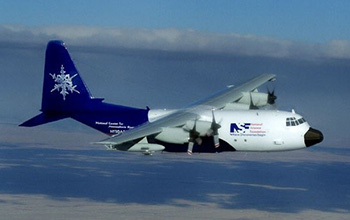搜索结果: 1-15 共查到“大气化学 Arctic”相关记录52条 . 查询时间(0.187 秒)

Researchers set to take to the air above the Arctic and New York City(图)
air above Arctic New York City
2020/10/10
Atmospheric scientists are embarking on two new research projects supported by the U.S. National Science Foundation that involve using sophisticated planes to understand the atmospheric chemistry and ...
On average, airborne aerosol particles cool the Earth's surface directly by absorbing and scattering sunlight and indirectly by influencing cloud reflectivity, life time, thickness or extent. Here we ...
Quantifying transport into the Arctic lowermost stratosphere
the Arctic lowermost stratosphere the Arctic vortex the Arctic winter 2003
2010/12/28
In the Arctic winter 2003, in-situ measurements of the long-lived trace gases N2O, CFC-11 (CCl3F), H-1211 (CBrClF2), CH4, O3 and H2O have been performed on board the high-altitude aircraft M55 Geophys...
Characterising aerosol transport into the Canadian High Arctic using aerosol mass spectrometry and Lagrangian modelling
aerosol transport the Canadian High Arctic aerosol mass spectrometry Lagrangian modelling
2010/11/30
We report the analysis of measurements made using an aerosol mass spectrometer (AMS; Aerodyne Research Inc.) that was installed in the Polar Environment Atmospheric Research Laboratory (PEARL) in summ...
Pathways of PFOA to the Arctic: variabilities and contributions of oceanic currents and atmospheric transport and chemistry sources
PFOA the Arctic oceanic currents atmospheric transport chemistry sources
2010/10/21
Perfluorooctanoic acid (PFOA) and other perfluorinated compounds are industrial chemicals in use for decades which resist degradation in the environment and seem to accumulate in polar regions. Transp...
Aircraft observations of enhancement and depletion of black carbon mass in the springtime Arctic
Aircraft observations black carbon mass the springtime Arctic
2010/10/21
Understanding the processes controlling black carbon (BC) in the Arctic is crucial for evaluating the impact of anthropogenic and natural sources of BC on Arctic climate. Vertical profiles of BC mass ...
A closer look at Arctic ozone loss and polar stratospheric clouds
Arctic ozone loss polar stratospheric clouds
2010/9/21
The empirical relationship found between column-integrated Arctic ozone loss and the potential volume of polar stratospheric clouds inferred from meteorological analyses is recalculated in a self-cons...
Atmospheric transport of persistent semi-volatile organic chemicals to the Arctic and cold condensation in the mid-troposphere – Part 2: 3-D modeling of episodic atmospheric transport
Atmospheric transport persistent semi-volatile organic chemicals the Arctic and cold condensation the mid-troposphere episodic atmospheric transport
2010/8/16
Two 3-dimensional global atmospheric transport models for persistent organic pollutants (POPs) have been employed to investigate the association between the large-scale atmospheric motions and polewar...
Atmospheric transport of persistent semi-volatile organic chemicals to the Arctic and cold condensation in the mid-troposphere – Part 1: 2-D modeling in mean atmosphere
Atmospheric transport persistent semi-volatile organic chemicals the Arctic and cold condensation the mid-troposphere mean atmosphere
2010/8/16
In the first part of this study for revisiting the cold condensation effect on global distribution of semi-volatile organic chemicals (SVOCs), the atmospheric transport of SVOCs to the Arctic in the m...
Chemistry of hydrogen oxide radicals (HOx) in the Arctic troposphere in spring
hydrogen oxide radicals the Arctic troposphere spring
2010/8/13
We use observations from the April 2008 NASA ARCTAS aircraft campaign to the North American Arctic, interpreted with a global 3-D chemical transport model (GEOS-Chem), to better understand the sources...
Circumpolar measurements of speciated mercury, ozone and carbon monoxide in the boundary layer of the Arctic Ocean
Circumpolar measurements speciated mercury ozone and carbon monoxide the boundary layer the Arctic Ocean
2010/8/13
Using the Swedish icebreaker Oden as a platform, continuous measurements of airborne mercury (gaseous elemental mercury (Hg0), divalent gaseous mercury species HgIIX2(g) (acronym RGM) and mercury atta...
Airborne measurements of aerosol optical properties related to early spring transport of mid-latitude sources into the Arctic
Airborne measurements aerosol optical properties mid-latitude sources the Arctic
2010/8/13
Airborne lidar and in-situ measurements of the aerosol properties were conducted between Svalbard Island and Scandinavia in April 2008. Evidence of aerosol transport from Europe and Asia is given. The...
AMALi – the Airborne Mobile Aerosol Lidar for Arctic research
AMALi the Airborne Mobile Aerosol Lidar Arctic research
2010/8/12
The Airborne Mobile Aerosol Lidar (AMALi) is an instrument developed at the Alfred Wegener Institute for Polar and Marine Research for reliable operation under the challenging weather conditions at th...
Evaluation of Arctic cloud products from the EUMETSAT Climate Monitoring Satellite Application Facility based on CALIPSO-CALIOP observations
Arctic cloud products EUMETSAT Climate Monitoring Satellite Application Facility CALIPSO-CALIOP
2010/2/21
The performance of the three cloud products cloud fractional cover, cloud type and cloud top height, derived from NOAA AVHRR data and produced by the EUMETSAT Climate Monitoring Satellite Application ...
Source attribution and interannual variability of Arctic pollution in spring constrained by aircraft (ARCTAS, ARCPAC) and satellite (AIRS) observations of carbon monoxide
Arctic pollution spring constrained ARCTAS carbon monoxide
2010/2/21
We use aircraft observations of carbon monoxide (CO) from the NASA ARCTAS and NOAA ARCPAC campaigns in April 2008 together with multiyear (2003–2008) CO satellite data from the AIRS instrument and a g...

